Water Distribution Systems in Pig Farm Buildings: Critical Elements of Design and Management
Abstract
:Simple Summary
Abstract
1. Introduction
2. Materials and Methods
3. Results
3.1. Farm Water Sources, On-Farm Water Storage Capacity, and Pipelines to Buildings
We haven’t expanded pig numbers, but our water system, we keep adding to it. We have different sources of water. We have bore water. We have dam water. We have town water and we have desalination water.
3.2. Buildings and WDSs within Buildings
The plumbing system has been added on to or changed every time they made a production change. Everything has just been added on over 35 years, and the whole thing is not ideal.
3.3. Drinkers for Pigs
I haven’t experimented with it, mainly because there is a code of practice in regards to the height off the ground for varying ages of pigs.
I feel the drinker height is too high. Slightly too high for the piglets when they first go in there. It feels like they need to be all dropped down, but that’s a big job in itself.
If (the drinker) is near feed, they tend to eat and drink and put on more weight with more feed being consumed.
My preference is to have the water off to the feeders and have two distinct stations—one drinking station and one feeding station. We did that (and) actually got a one kilo weight gain difference between the traditional and modified systems.
3.4. Changes in Daily Water Flow in WDSs as Each Batch of Pigs Is Reared
3.5. Monitoring WDS Function and Water Quality
I live 15, 20 min away. In the middle of summer on a weekend you’ve got to come out and have a look at the pumps. If you could dial up on your phone and check that the pressure gauges are fine or that the tank is full—there’s no need to go there.
We always had an issue of blowing water pipes, creating havoc for us. So we changed over to variable speed drive pumps.
We run two pumps in our dam. They continually alternate, so we’re getting the same amount of hours on each pump. If I have one pump break down, I’ll just run the other one on manual.
Unfortunately, all our water lines are up near the roofs. We’ve done some tests in the shelters where the water doesn’t move as much. It took me 10 min after taking off a nipple to have that water cooled down enough to drink on those hot days.
3.6. WDS Sanitization Practices
We’ve had some issues with slimy muck build up in the lines. Now when we empty the shed, we run the water tank down to about 500 litres of water, and we run acid through the line when the shed’s empty and clean the lines out.
I think about it (cleaning and sanitisation) from time to time, but that doesn’t mean action!
4. Discussion
4.1. Looped vs. Branched WDSs
4.2. Over-Sized Pig Building WDSs
4.3. Pigs’ Access to Water
4.4. WDS Sanitization Practices
4.5. Use of Water-Usage Metering and Alert Systems
4.6. Limitations of the Study
5. Conclusions
Supplementary Materials
Author Contributions
Funding
Institutional Review Board Statement
Informed Consent Statement
Data Availability Statement
Acknowledgments
Conflicts of Interest
Appendix A
| Characteristic | Proportion of Study Participants (N) |
|---|---|
| Gender: | |
| Male | 23/25 |
| Female | 2/25 |
| Age: | |
| <25 | 0/25 |
| 25–34 | 1/25 |
| 35–44 | 5/25 |
| 45–54 | 9/25 |
| >55 | 10/25 |
| Years working in the pig industry: | |
| <2 | 0/25 |
| 2–5 | 1/25 |
| 6–10 | 3/25 |
| >10 | 21/25 |
| Years managing the current farm: | |
| <2 | 6/25 |
| 2–5 | 3/25 |
| 6–10 | 4/25 |
| >10 | 12/25 |
| Characteristic | Proportion of Study Farms (%) |
|---|---|
| Location [state of Australia]: | |
| South Australia | 9/25 (36%) |
| Victoria | 8/25 (32%) |
| New South Wales | 6/25 (24%) |
| Queensland | 2/25 (8%) |
| Animals on farm: | |
| Sows, boars, and growing pigs | 12/25 (48%) |
| Growing pigs only | 13/25 (52%) |
| Single- or multiple-site configuration: | |
| Single | 18/25 (72%) |
| Multiple | 7/25 (28%) |
| Weaner pig buildings described in questionnaire: | |
| Type: | |
| Conventional with solid/slatted/mesh-floored pens | 24/40 (60%) |
| Eco-shelters with straw-floor pens | 16/40 (40%) |
| Age of buildings: | |
| <2 years | 9/40 (22%) |
| 3–10 years | 0/40 (0%) |
| 11–20 years | 13/40 (33%) |
| 20 years | 18/40 (45%) |
| Grower/finisher pig buildings described in questionnaire: | |
| Type: | |
| Conventional with solid/slatted/mesh-floored pens | 31/48 (65%) |
| Eco-shelters with straw-floor pens | 17/48 (35%) |
| Age of buildings: | |
| <2 years | 11/88 (12%) |
| 3–10 years | 5/88 (6%) |
| 11–20 years | 26/88 (30%) |
| ≥20 years | 46/88 (52%) |
| Pig flow in weaner buildings: | |
| All-in-all-out by room or building | 38/40 (95%) |
| Continuous flow | 2/40 (5%) |
| Pig flow in grower/finisher buildings: | |
| All-in-all-out by room or building | 38/48 (79%) |
| Continuous flow | 10/48 (21%) |
References
- Brooks, P.H. Water–Forgotten nutrient and novel delivery system. In Biotechnology in the Feed Industry; Lyons, T.P., Jacques, K.A., Eds.; Nottingham Press: Leicestershire, UK, 1994; pp. 211–234. [Google Scholar]
- Harvey, R.E. Water consumption. Pig J. 1994, 32, 95–98. [Google Scholar]
- Li, Y.Z.; Chénard, L.; Lemay, S.P.; Gonyou, H.W. Water intake and wastage at nipple drinkers by growing-finishing pigs. J. Anim. Sci. 2005, 83, 1413–1422. [Google Scholar] [CrossRef] [PubMed] [Green Version]
- Brumm, M. Understanding feeders and drinkers for grow-finish pigs. In Congreso Nacional de Producción Porcina; Río Cuarto, A., Ed.; Memorias Río Cuarto, Universidad Nacional de Río Cuarto: Córdoba, Argentina, 2010; pp. 27–37. [Google Scholar]
- Turner, S.P.; Sinclair, A.G.; Edwards, S.A. The interaction of liveweight and the degree of competition on drinking behaviour in growing pigs at different group sizes. Appl. Anim. Behav. Sci. 2000, 67, 321–334. [Google Scholar] [CrossRef]
- Soraci, A.L.; Amanto, F.; Tapia, M.O.; de la Torre, E.; Toutain, P.-L. Exposure variability of fosfomycin administered to pigs in food or water: Impact of social rank. Res. Vet. Sci. 2014, 96, 153–159. [Google Scholar] [CrossRef] [PubMed]
- Turner, S.P.; Edwards, S.A.; Bland, V.C. The influence of drinker allocation and group size on the drinking behaviour, welfare and production of growing pigs. Anim. Sci. J. 1999, 68, 617–624. [Google Scholar] [CrossRef]
- Little, S.; Woodward, A.; Browning, G.; Billman-Jacobe, H. Effect of Drinking Water Distribution System Design on Antimicrobial Delivery to Pigs. Animals 2021, 11, 2362. [Google Scholar] [CrossRef]
- Kourbasis, N.; Patelis, M.; Tsitsifli, S.; Kanakoudis, V. Optimizing water age and pressure in drinking water distribution networks. Environ. Sci. Proc. 2020, 2, 51. [Google Scholar] [CrossRef]
- Little, S.B.; Crabb, H.K.; Woodward, A.P.; Browning, G.F.; Billman-Jacobe, H. Review: Water medication of growing pigs: Sources of between-animal variability in systemic exposure to antimicrobials. Animal 2019, 13, 3031–3040. [Google Scholar] [CrossRef] [Green Version]
- Little, S.; Woodward, A.; Browning, G.; Billman-Jacobe, H. In-Water Antibiotic Dosing Practices on Pig Farms. Antibiotics 2021, 10, 169. [Google Scholar] [CrossRef]
- Fertner, M.; Boklund, A.; Dupont, N.; Toft, N. Changes in group treatment procedures of Danish finishers and its influence on the amount of administered antimicrobials. Prev. Vet. Med. 2016, 126, 89–93. [Google Scholar] [CrossRef] [Green Version]
- Page, S.; Gautier, P. Use of antimicrobial agents in livestock. Rev. Sci. Et Tech. OIE 2012, 31, 145–188. [Google Scholar] [CrossRef]
- Toutain, P.-L.; Lees, P. The population PK/PD approach for a rational use of anti-infective drugs to minimize resistance. J. Veter. Pharmacol. Ther. 2006, 29, 26–29. [Google Scholar] [CrossRef]
- Lees, P.; Pelligand, L.; Ferran, A.; Bousquet-Melou, A.; Toutain, P.-L. Application of pharmacological principles to dosage design of antimicrobial drugs. Pharmacol. Matters 2015, 8, 22–24. [Google Scholar]
- Tashakkori, A.; Teddlie, C. SAGE Handbook of Mixed Methods in Social & Behavioral Research; SAGE Publishing: Thousand Oaks, CA, USA, 2010; ISBN 9781412972666. [Google Scholar]
- Regnault, A.; Willgoss, T.; Barbic, S. On behalf of the International Society for Quality of Life Research Mixed Methods Special Interest Group. Towards the use of mixed methods inquiry as best practice in health outcomes research. J. Patient-Rep. Outcomes 2018, 2, 19. [Google Scholar] [CrossRef] [PubMed] [Green Version]
- Almeida, F. Strategies to perform a mixed methods study. Eur. J. Educ. 2018, 5, 137–151. [Google Scholar] [CrossRef]
- Cresswell, J.W.; Creswell, J.D. Research Design: Qualitative, Quantitative and Mixed Methods Approaches, 5th ed.; SAGE Publishing: Thousand Oaks, CA, USA, 2017; ISBN 9781506386768. [Google Scholar]
- Australian Pork Limited. Australian Pork Industry Quality Assurance Program. Available online: http://www.apiq.com.au (accessed on 18 August 2021).
- The R Project for Statistical Computing. Available online: https://www.r-project.org/ (accessed on 18 August 2021).
- Braun, V.; Clarke, V. Using thematic analysis in psychology. Qual. Res. Psychol. 2006, 3, 77–101. [Google Scholar] [CrossRef] [Green Version]
- Australian Pork Limited. Import, Export, and Domestic Production Report. June 2020. Available online: https://australianpork.com.au/market-reports (accessed on 18 August 2021).
- Brumm, M.C. Patterns of Drinking Water Use in Pork Production Facilities; Nebraska Swine Report; University of Nebraska-Lincoln: Lincoln, NE, USA, 2006; pp. 10–14. Available online: https://digitalcommons.unl.edu/coopext_swine/221/ (accessed on 18 August 2021).
- King, R. Water Supply to Pigs; A Report Prepared for the Pig Research and Development Corporation; PRDC: Roseworthy, SA, Australia, 1999; DV172/1497. [Google Scholar]
- Australian Pork Limited. Producers’ Guide to Pig Production & Nutrition. 2017. Available online: https://www.australianpork.com.au/sites/default/files/2021-07/2017-APL-Producers-Guide-to-Pig-Production-and-Nutrition.pdf (accessed on 18 August 2021).
- PIC UK Limited. PIC Wean to Finish Guidelines. 2019. Available online: https://gb.pic.com/wp-content/uploads/sites/9/2018/12/Wean_To_Finish_Manual_2019_A4_UK_LowRes.pdf (accessed on 18 August 2021).
- Gonyou, H.W. Water Use and Drinker Management; Prairie Swine Centre 1996 Annual Report; Prairie Swine Centre Inc.: Saskatoon, SK, Canada, 1996; pp. 74–80. [Google Scholar]
- Watts, P.J.; Davis, R.J.; Keane, O.B.; Luttrell, M.M.; Tucker, R.W.; Stafford, R.; Janke, S.; Meat & Livestock Australia Ltd. Beef Cattle Feedlots: Design and Construction. 2016. Available online: https://www.mla.com.au/globalassets/mla-corporate/research-and-development/documents/beef-cattle-feedlots---design-and-construction---web2.pdf (accessed on 18 August 2021).
- Gilbert, J.A. Practical Design of Water Distribution Systems; PDH Course C182; PDH Online|PDH Center: Fairfax, VA, USA, 2012; Available online: https://pdhonline.com/courses/c182/c182content.pdf (accessed on 18 August 2021).
- Global Asset Protection Services LLC. Testing and Analyzing Looped Water Supplies; GAPS Guidelines GAP.14.1.2.3; Global Asset Protection Services: Hartford, CT, USA, 2015; pp. 1–6. [Google Scholar]
- Zhou, X.; Zhang, K.; Zhang, T.; Li, C.; Mao, X. An ignored and potential source of taste and odor (T&O) issues—biofilms in drinking water distribution system (DWDS). Appl. Microbiol. Biotechnol. 2017, 101, 3537–3550. [Google Scholar] [CrossRef]
- Banhazi, T.M.; Rutley, D.L. Factors influencing water temperature on farms and the effect of warm drinking water on pig growth. In Livestock Housing: Modern Management to Ensure Optimal Health and Welfare of Farm Animals; Aland, A., Banhazi, T.M., Eds.; Wageningen Academic Publishers: Wageningen, The Netherlands, 2013; pp. 147–159. [Google Scholar]
- Reese, D.; Brumm, M. G86-821 Weaned Pig Management and Nutrition (Revised August 1992) (1986). Historical Materials from University of Nebraska-Lincoln Extension. 1373. Available online: https://digitalcommons.unl.edu/extensionhist/1373 (accessed on 18 August 2021).
- Brumm, M. Water Systems for Swine. Pork Information Gateway Fact Sheet PIG 07-02-01. Available online: https://porkgateway.org/resource/water-systems-for-swine-2/ (accessed on 18 August 2021).
- Australian Pork Limited. Fact. Sheet: Water Supply to Pigs; Australian Pork Limited: Barton, ACT, Australia, 2016; pp. 1–4. [Google Scholar]
- Barber, J.; Brooks, P.H.; Carpenter, J.L. The effects of water delivery rate on the voluntary food intake, water use and performance of early-weaned pigs from 3 to 6 weeks of age. In The Voluntary Food Intake of Pigs; Forbes, J.M., Varley, M.A., Lawrence, T.J.L., Eds.; Occasional Publication No. 13; British Society of Animal Production: Midlothian, UK, 1989; pp. 103–104. [Google Scholar]
- Brooks, P.H.; Carpenter, J.L. The water requirement of growing-finishing pigs—theoretical and practical considerations. In Recent Advances in Animal Nutrition; Haresign, W., Cole, D.J.A., Eds.; Butterworths: Sevenoaks, UK, 1990; pp. 115–136. [Google Scholar]
- Nienaber, J.A.; Hahn, G.L. Effects of water flow restriction and environmental factors on performance of nursery-age pigs. J. Anim. Sci. 1984, 59, 1423–1429. [Google Scholar] [CrossRef]
- Pagel, M.; Dawkins, M.S. Peck orders and group size in laying hens: ‘futures contracts’ for non-aggression. Behav. Process. 1997, 40, 13–25. [Google Scholar] [CrossRef]
- Estevez, I.; Keeling, L.J.; Newberry, R.C. Decreasing aggression with increasing group size in young domestic fowl. Appl. Anim. Behav. Sci. 2003, 84, 213–218. [Google Scholar] [CrossRef]
- Estevez, I.; Andersen, I.-L.; Nævdal, E. Group size, density and social dynamics in farm animals. Appl. Anim. Behav. Sci. 2007, 103, 185–204. [Google Scholar] [CrossRef]
- Andersen, I.L.; Nævdal, E.; Bakken, M.; Bøe, K.E. Aggression and group size in domesticated pigs, Sus scrofa: ‘when the winner takes it all and the loser is standing small’. Anim. Behav. 2004, 68, 965–975. [Google Scholar] [CrossRef]
- Samarakone, T.S.; Gonyou, H.W. Domestic pigs alter their social strategy in response to social group size. Appl. Anim. Behav. Sci. 2009, 121, 8–15. [Google Scholar] [CrossRef]
- McGlone, J.J.; Newby, B.E. Space requirements for finishing pigs in confinement: Behavior and performance while group size and space vary. Appl. Anim. Behav. Sci. 1994, 39, 331–338. [Google Scholar] [CrossRef]
- Stambuk, C.R.; Sadler, L.J.; DuBois, P.R.; Edler, R.A.; Holck, J.T.; Jackson, C.J.; Kattiker, L.A.; Stalder, K.J.; Johnson, A.K. More Nipple Cup Drinkers to Fewer Pigs on the Day of Weaning Into a Conventional Nursery Results in Reduced Aggression and More Visits to the Drinker. J. Anim. Sci. Livest. Prod. 2020, 4, 3. [Google Scholar]
- Jackson, C. Drinker to nursery pig ratio: Drinking behaviour, aggression, and drinker location preference over 2 days. J. Swine Health Prod. 2020, 29, 81–89. [Google Scholar]
- Euken, R.M. Swine Feed Efficiency: Impact of Feeder Design and Management 2012. Iowa Pork Industry Center Fact Sheets. 6. Available online: http://lib.dr.iastate.edu/ipic_factsheets/6 (accessed on 18 August 2021).
- Muhlbauer, R.V.; Moody, L.B.; Burns, R.T.; Harmon, J.; Stalder, K. Water Consumption and Conservation Techniques Currently Available for Swine Production; National Pork Board: Des Moines, IA, USA, 2010. [Google Scholar]
- He, Y.; Yuan, Q.; Mathieu, J.; Stadler, L.; Senehi, N.; Sun, R.; Alvarez, P.J.J. Antibiotic resistance genes from livestock waste: Occurrence, dissemination, and treatment. NPJ Clean Water 2020, 3, 4. [Google Scholar] [CrossRef] [Green Version]
- Scott, A.B.; Singh, M.; Groves, P.; Hernandez-Jover, M.; Barnes, B.; Glass, K.; Moloney, B.; Black, A.; Toribio, J.-A. Biosecurity practices on Australian commercial layer and meat chicken farms: Performance and perceptions of farmers. PLoS ONE 2018, 13, e0195582. [Google Scholar] [CrossRef]
- Scott, P.; Ahern, T. National Water Biosecurity Manual–Poultry Production. Scolexia Animal and Avian Health Consultancy and Department of Agriculture Fisheries & Forestry, Commonwealth of Australia. 2009. Available online: https://www.agriculture.gov.au/sites/default/files/documents/national-water-biosecurity-manual-poultry-production.pdf (accessed on 18 August 2021).
- Agriculture and Horticulture Development Board. Deep Cleaning Farm Drinking Systems. A Shock Water Treatment Guide. 2019. Available online: https://projectblue.blob.core.windows.net/media/Default/Pork/Documents/Deep%20cleaning%20farm%20drinking%20systems (accessed on 18 August 2021).
- Douterelo, I.; Husband, S.; Boxall, J.B. The bacteriological composition of biomass recovered by flushing an operational drinking water distribution system. Water Res. 2014, 54, 100–114. [Google Scholar] [CrossRef] [Green Version]
- Yu, J.; Kim, D.; Lee, T. Microbial diversity in biofilms on water distribution pipes of different materials. Water Sci. Technol. 2010, 61, 163–171. [Google Scholar] [CrossRef]
- Jang, H.-J.; Choi, Y.-J.; Ka, J.-O. Effects of diverse water pipe materials on bacterial communities and water quality in the annular reactor. J. Microbiol. Biotechnol. 2011, 21, 115–123. [Google Scholar] [CrossRef] [PubMed] [Green Version]
- Dewulf, J.; Van Immerseel, F. Biosecurity in Animal Production and Veterinary Medicine: From Principles to Practice; Centre for Agriculture and Bioscience International: Wallingford, UK, 2020; ISBN 978-1-78924-568-4. [Google Scholar]
- Davies, R.; Wales, A. Antimicrobial Resistance on Farms: A Review Including Biosecurity and the Potential Role of Disinfectants in Resistance Selection. Compr. Rev. Food Sci. Food Saf. 2019, 18, 753–774. [Google Scholar] [CrossRef] [PubMed] [Green Version]
- Schillings, J.; Bennett, R.; Rose, D.C. Exploring the Potential of Precision Livestock Farming Technologies to Help Address Farm Animal Welfare. Front. Anim. Sci. 2021, 2, 639678. [Google Scholar] [CrossRef]
- Crabtree, H.G.; Bird, N.; Ravn, L.; Edwards, S.A. Changes in water intake patterns as an automated early indicator of pig welfare problems. In Proceedings of the 4th International Workshop on the Assessment of Animal Welfare at Farm and Group Level, Ghent, Belgium, 10–13 September 2008. [Google Scholar]
- Vranken, E.; Berckmans, D. Precision livestock farming for pigs. Anim. Front. 2017, 7, 32–37. [Google Scholar] [CrossRef] [Green Version]
- Schukat, S.; Heise, H. Smart Products in Livestock Farming—An Empirical Study on the Attitudes of German Farmers. Animals 2021, 11, 1055. [Google Scholar] [CrossRef]
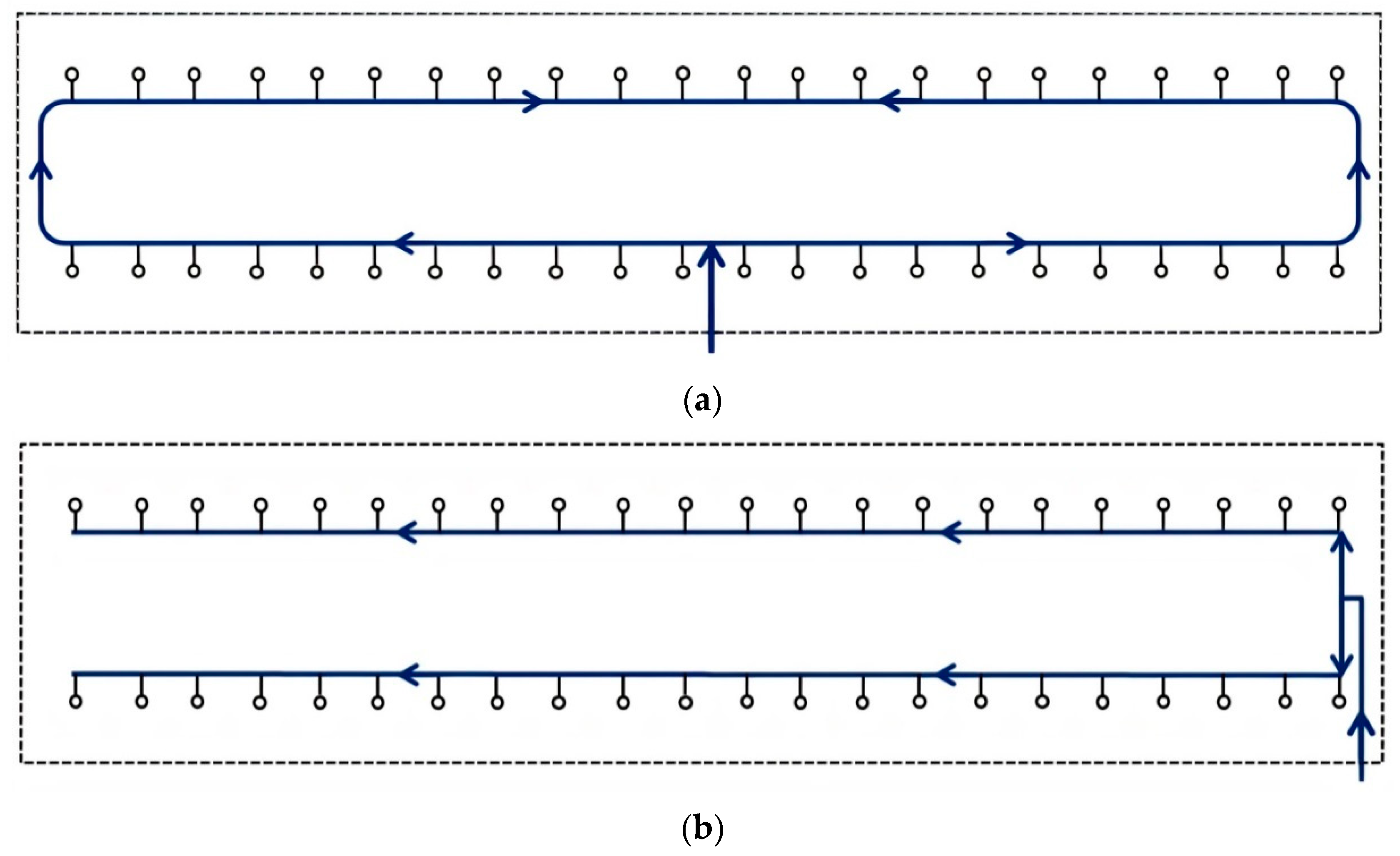
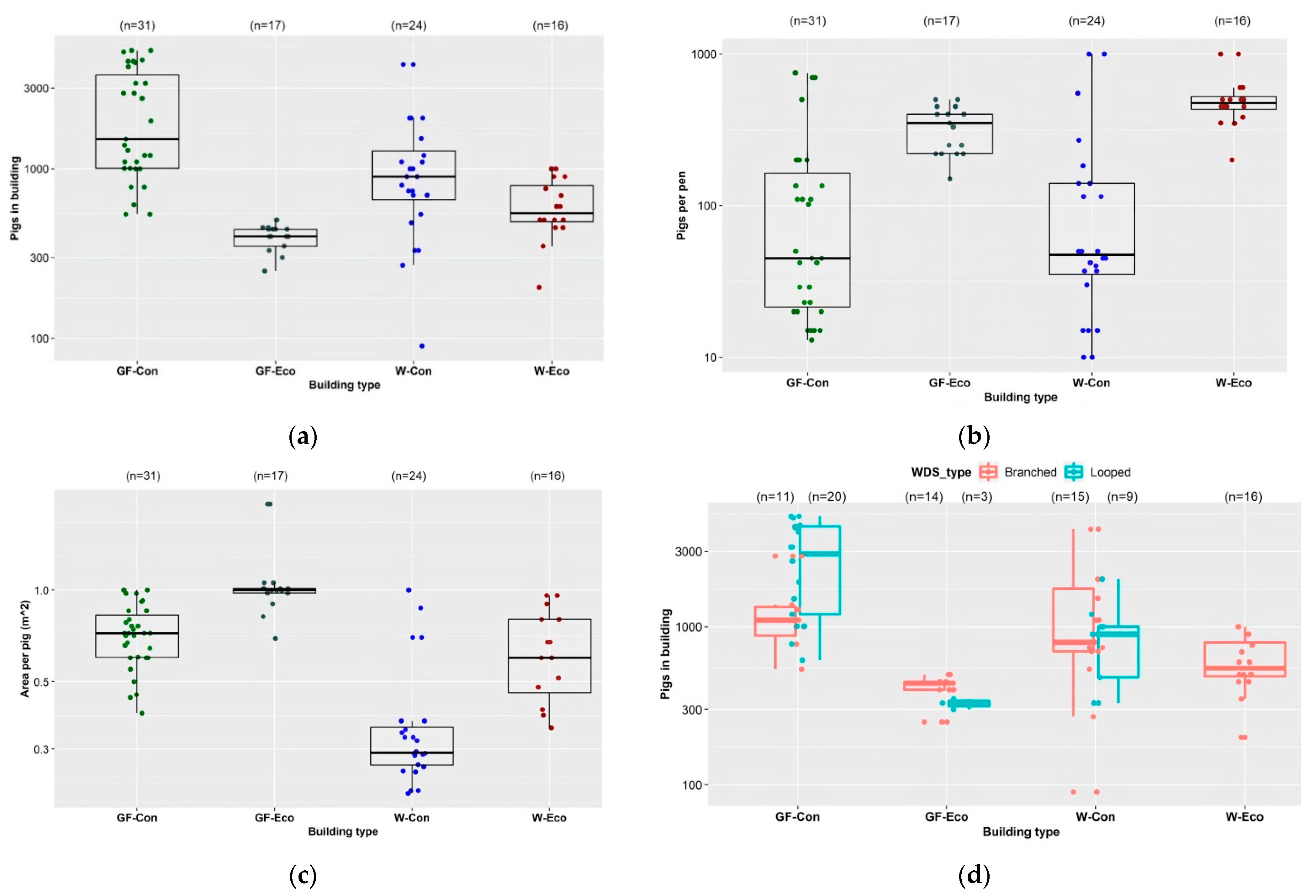
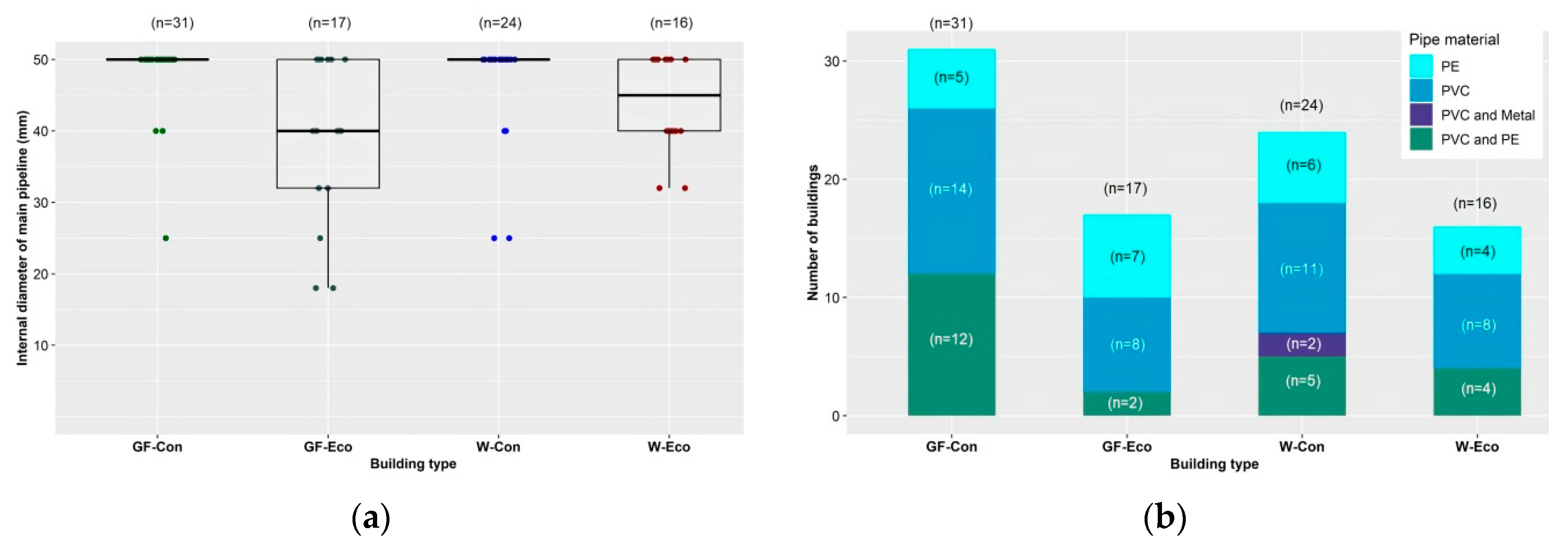
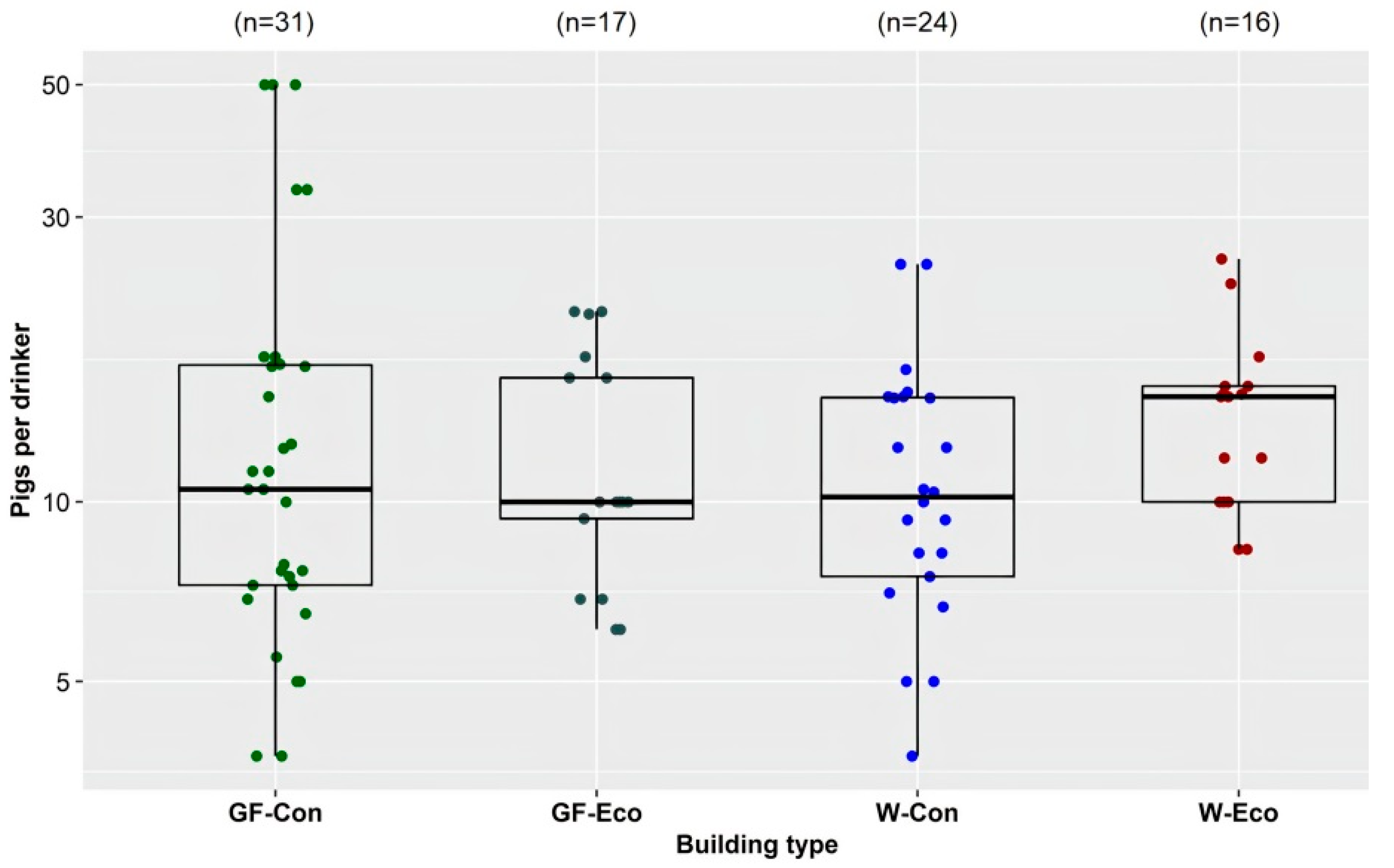
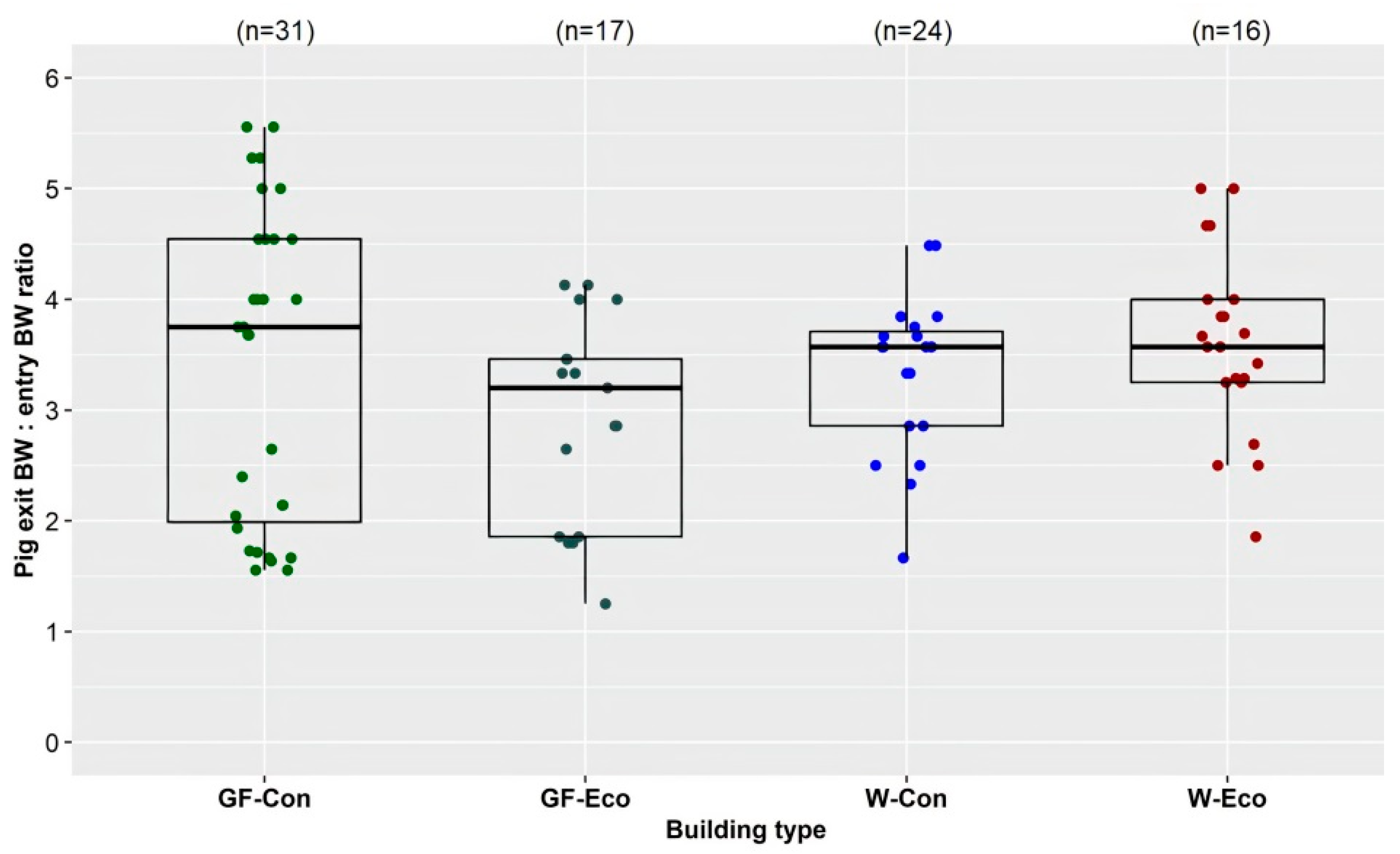
Publisher’s Note: MDPI stays neutral with regard to jurisdictional claims in published maps and institutional affiliations. |
© 2021 by the authors. Licensee MDPI, Basel, Switzerland. This article is an open access article distributed under the terms and conditions of the Creative Commons Attribution (CC BY) license (https://creativecommons.org/licenses/by/4.0/).
Share and Cite
Little, S.; Woodward, A.; Browning, G.; Billman-Jacobe, H. Water Distribution Systems in Pig Farm Buildings: Critical Elements of Design and Management. Animals 2021, 11, 3268. https://doi.org/10.3390/ani11113268
Little S, Woodward A, Browning G, Billman-Jacobe H. Water Distribution Systems in Pig Farm Buildings: Critical Elements of Design and Management. Animals. 2021; 11(11):3268. https://doi.org/10.3390/ani11113268
Chicago/Turabian StyleLittle, Stephen, Andrew Woodward, Glenn Browning, and Helen Billman-Jacobe. 2021. "Water Distribution Systems in Pig Farm Buildings: Critical Elements of Design and Management" Animals 11, no. 11: 3268. https://doi.org/10.3390/ani11113268
APA StyleLittle, S., Woodward, A., Browning, G., & Billman-Jacobe, H. (2021). Water Distribution Systems in Pig Farm Buildings: Critical Elements of Design and Management. Animals, 11(11), 3268. https://doi.org/10.3390/ani11113268








